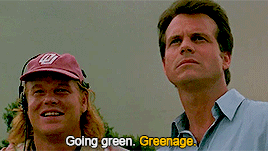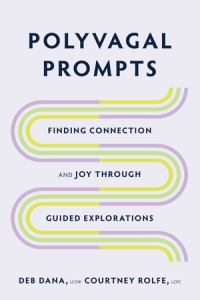Naming our experience begins the process of letting go of judgment and self-blame and making room for curiosity.
I first encountered Polyvagal Theory about a year ago but initially had trouble getting past the sciencey bits so hadn’t made it to the understanding part. That changed when I read Our Polyvagal World by Stephen Porges and Seth Porges. So many lightbulbs went off in my head I may as well have had the sun in there.
Suddenly I made sense to me. Not only that, other people also made sense. My optimism was tempered by a history of thinking something’s a great idea, knowing it would be better for me if I incorporated it into my life and momentum fading as life invariably happens.
This stuck, though, so much so that I now think in terms of colours. Thanks to the bazillion times I watched Twister in the late 90’s, I began to think of the ventral vagal state as ‘greenage’.

Thanks, Dusty!
And you know what? It also stuck and I’m delighted to report that apparently it’s contagious. The fun of hearing people who usually speak quite formally casually mentioning greenage makes my green that much brighter.
Needless to say, I couldn’t wait to read more about Polyvagal Theory. I started at the end of this book because of course I did. Actually, it is suggested as an option in the Introduction so this wasn’t me going rogue.
There you’ll find A Beginner’s Guide to Polyvagal Theory and a glossary. The Beginner’s Guide can act as either an introduction or a refresher. I found it helpful to revisit what I’d previously learnt.
The guided prompts are presented in a logical progression, although you can work through them in any order. I’d be interested to discover how my answers change over time.
I absolutely loved the haiku examples to describe each state. I’ve gotten so used to understanding what state I’m experiencing in terms of colour, I tend to get confused when I read dorsal, sympathetic and ventral. These helped a lot.
Dorsal:
How long have I sat
No voice, no movement, slow breath
Far away from you
Sympathetic:
Look around, danger
Who is safe and who is not?
Get me out of here
Ventral:
A bright heart beaming
Wrapping all with love and warmth
Holding space for you
Overall, I was encouraged, knowing that I’m still implementing what I learned from reading Our Polyvagal World. I also appreciated being reminded of some things I’ve unintentionally let go of along the way. I plan to pay closer attention so I notice glimmers throughout my day and will be on the lookout for awe inspiring moments.
I’m keen to read more about Polyvagal Theory so don’t be surprised if you hear more about it from me in the near future.
Thank you so much to NetGalley and W. W. Norton & Company for the opportunity to read this book.
Once Upon a Blurb
Discover the remarkable ways your nervous system works in service of your safety and wellbeing.
Polyvagal Theory, developed by researcher and scientist Dr. Stephen Porges and popularised by therapist Deb Dana, has impacted countless lives. It has changed the way therapists work with their clients and provided a pathway toward healing for those who have experienced hardship or trauma.
In Polyvagal Prompts, Deb Dana and Courtney Rolfe invite readers to explore their nervous systems through Polyvagal Theory with engaging questions and exercises, which readers can respond to directly in the pages of the book. Readers are guided in noticing their systems, listening with curiosity, and reflecting on what they learn. The prompts can be used as a daily practice or to explore specific topics at the reader’s own pace, and are also ideal for helping clients track and reflect upon their polyvagal-informed therapies.
No matter how readers decide to explore, Polyvagal Prompts offers an invaluable opportunity to begin the life changing journey of befriending one’s nervous system.
